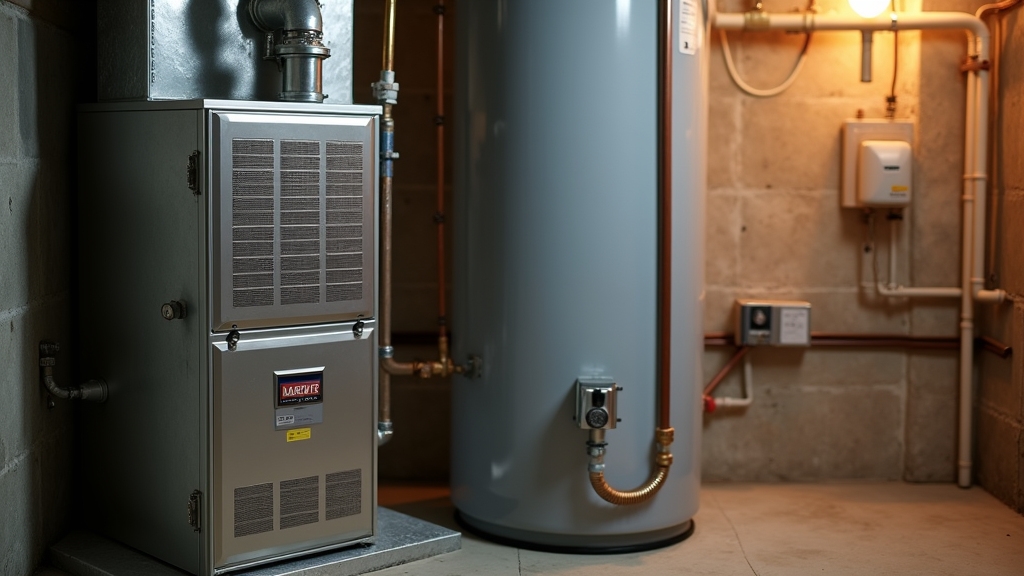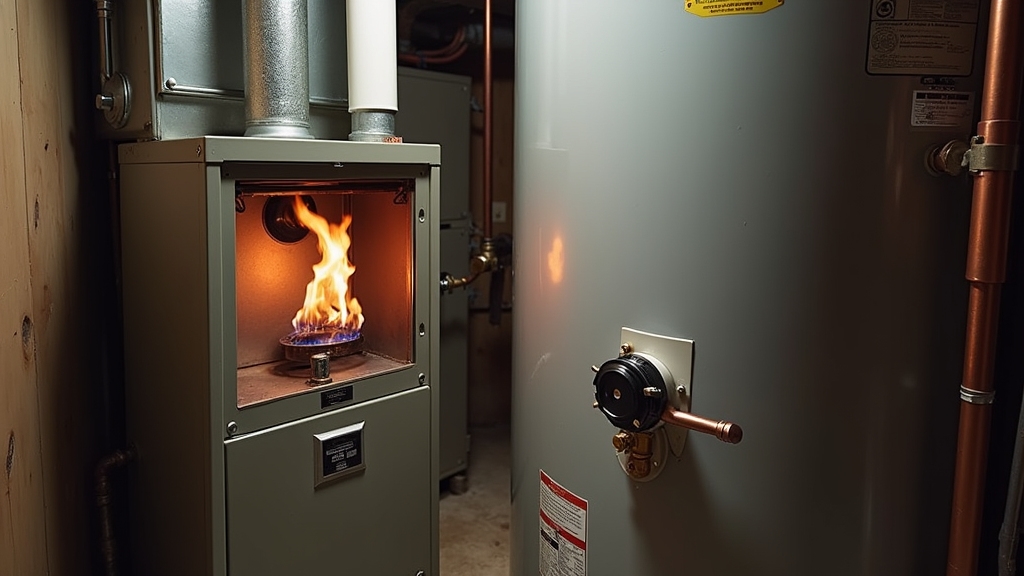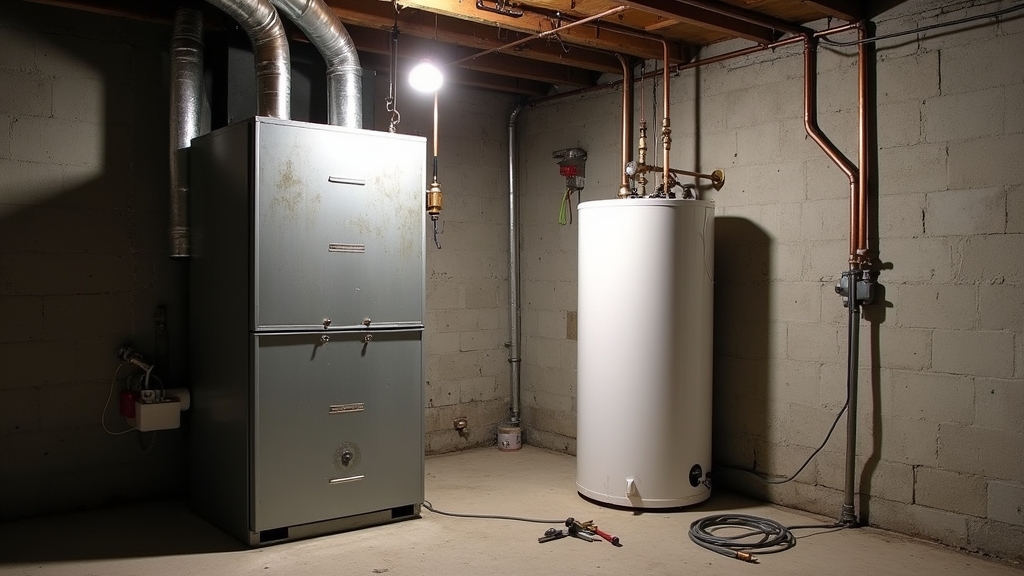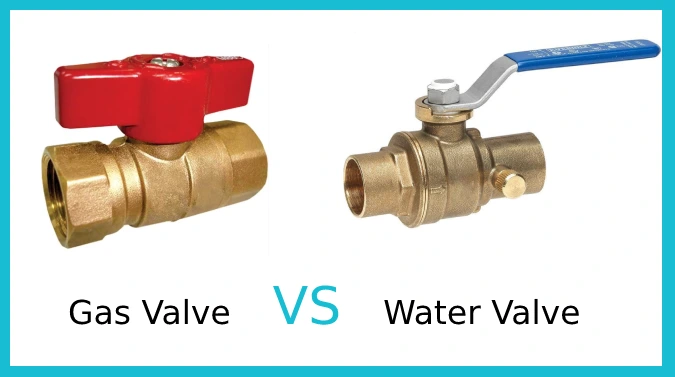You use a furnace to heat air and warm your home, while a hot water heater supplies hot water for showers, washing, and sinks—each serving distinct roles. Furnaces rely on combustion or electric elements and distribute heat through ducts.
Hot water heaters store or heat water on demand, often via gas or electric power. Both require proper installation and maintenance for optimal efficiency and safety. Understanding their distinct differences helps you manage your home systems more effectively, and grasping these basics lays the groundwork for deeper insights.
- Consistent And Efficient Heating For Every Room: The Rinnai direct vent wall heater ensures optimal…
- Safe And User-Friendly Design For Peace Of Mind: This wall mounted heater features a…
- Energy Savings Without Compromise: Our energy efficient space heater minimizes fuel consumption by…
- CONVENIENT HOT WATER HEATER: 2.5 gallon point-of-use mini-tank fits under your sink to provide hot…
- LONG LASTING QUALITY: This electric water heater is easy to maintain and has premium glass-lined…
- INDEPENDENT INSTALLATION: 36-37″ cord plugs into a 120 volt outlet for independent installation or…
Key Takeaways
- Furnaces heat air for indoor space heating, distributing warmth through ductwork; hot water heaters provide heated water for domestic use only.
- Furnaces use combustion or electric elements to warm air, while hot water heaters heat and store water for showers, cleaning, and appliances.
- Furnace efficiency ranges from 80-98% AFUE; tank water heaters operate at 60-80%, with tankless models boosting efficiency up to 99%.
- Furnaces impact indoor air temperature and quality, requiring ventilation and filter maintenance; hot water heaters do not affect air temperature or air quality.
- Proper maintenance differs: furnaces need filter changes and burner cleaning; water heaters require sediment flushing and anode rod replacement.
Hot Water Heater vs Furnace: Side-by-Side Comparison
| Feature | Furnace | Hot Water Heater |
|---|---|---|
| Primary Function | Heats air for space heating throughout home | Provides hot water for domestic use only |
| Heat Distribution | Forced air through ductwork system | Direct water supply to faucets and appliances |
| Energy Sources | Natural gas, propane, oil, or electricity | Gas, electric, solar, or heat pump technology |
| Efficiency Range | 80-98% AFUE ratings for modern units | 60-99% depending on tankless vs tank design |
| Installation Location | Basement, utility room, or dedicated space | Basement, garage, or utility closet |
| Operating Season | Primarily winter heating months | Year-round operation for consistent hot water |
| Maintenance Frequency | Annual inspections and filter changes | Sediment flushing and valve testing as needed |
| Average Lifespan | 15-20 years with proper maintenance | 8-12 years for tank, 20+ years for tankless |
| Monthly Energy Impact | Higher winter bills due to space heating | Consistent year-round hot water costs |
| Smart Home Integration | Programmable thermostats and zoning | Temperature controls and leak detection systems |
Functionality and Primary Uses

Although furnaces and hot water heaters both generate heat, they serve distinct purposes within a building’s infrastructure. You’ll find that furnaces heat air to warm interior spaces by transferring combustion or electric element heat through a heat exchanger.
The heated air circulates via a blower and ductwork, responding to thermostat signals to maintain set temperatures. Modern furnaces can reach up to 98% efficiency, reducing energy waste and operating costs. Proper maintenance of related components, like float valves, ensures systems avoid water damage and operate efficiently.
Furnaces primarily provide forced-air environmental heating throughout living areas during cold months and integrate with HVAC systems for climate control. Furnaces deliver forced-air warmth to living spaces in winter, seamlessly working with HVAC for overall climate control.
In contrast, hot water heaters focus solely on heating water for domestic use—showers, dishwashers, and laundry. They heat water either in tanks or on-demand without affecting indoor air temperature. The water level in some systems is regulated automatically by float valves to prevent overflow and maintain constant supply.
Hot water heaters operate independently from HVAC, supplying consistent hot water year-round through plumbing systems for hygiene and household chores.
Energy Efficiency Comparison
Understanding the distinct roles of furnaces and hot water heaters sets the stage for evaluating their energy efficiency. Furnaces typically achieve 80-98% AFUE ratings, efficiently heating entire living spaces, while conventional tank water heaters operate at 60-80%.
Tankless water heaters improve efficiency to 80-99% by heating water on demand, avoiding standby losses. Boilers, which heat water or steam for distribution through radiators or baseboards, generally operate with higher efficiency but come with higher installation costs. Consider environmental impacts when choosing a heating system.
Electric water heaters convert about 98% of energy into heat, often outperforming gas models in pure energy use. However, furnaces consume more energy overall due to larger heating demands. Your choice should consider these efficiencies alongside household usage and climate.
High-AFUE furnaces cut heating bills considerably, while tankless water heaters offer long-term savings despite higher upfront costs. Balancing efficiency with operational needs ensures optimized energy consumption and cost-effectiveness.
Typical Energy Sources and Operation Methods

When selecting between a furnace and a hot water heater, knowing their typical energy sources and operation methods helps you make an informed choice. Furnaces primarily use natural gas, propane, or heating oil, burning fuel in a combustion chamber to heat air via a heat exchanger. Electric furnaces use resistance coils, while hybrid systems combine gas and electric heat pumps.
A blower motor circulates warm air through ducts, with safety assured by flame sensors. The combustion byproducts are safely expelled outside through a flue pipe, ensuring indoor air quality. Proper airflow and pressure regulation are critical for maintaining furnace efficiency and safety.
Hot water heaters operate by burning gas or oil to heat water stored in tanks or on-demand in tankless systems. Electric versions use resistance elements, and heat pump water heaters extract ambient heat efficiently.
Solar thermal integration is also possible. Intake components and discharge mechanisms ensure the water heater operates reliably and prevents backflow, similar to a check valve function.
Installation Requirements and Maintenance Needs
When installing a furnace or hot water heater, you’ll need to follow distinct clearance and connection requirements specific to each system. Proper furnace placement is crucial, such as elevating units in garages at least 18 inches from the floor to prevent fire hazards.
Routine maintenance tasks differ as well, with furnaces requiring regular filter changes and duct inspections. Water heaters need sediment flushing and valve testing. Scheduling professional inspections annually guarantees both units operate safely and efficiently.
Understanding the pressure energy accumulation in hot water systems can help optimize performance and longevity.
Installation Process Differences
Although both furnaces and hot water heaters serve essential home functions, their installation processes differ considerably in requirements and maintenance. Furnaces demand precise sizing, ductwork evaluation, and secure fuel or electrical connections.
Proper sizing also helps in optimizing power consumption by reducing energy waste. Hot water heaters require licensed plumbing, adequate electrical capacity, and suitable location for air circulation.
Additionally, budgeting for potential electrical upgrades is important when installing heat pump water heaters to ensure sufficient power supply and system compatibility cost and incentives.
| Aspect | Furnace | Hot Water Heater |
|---|---|---|
| Sizing | Matches home size and climate | Based on water demand and space |
| Ventilation | Mandatory combustion gas exhaust | Requires open air volume |
| Professional Skills | HVAC technician specialization | Plumber and possibly electrician |
| Installation Time | 4-8 hours | Varies with complexity |
Routine Maintenance Tasks
Proper routine maintenance keeps both furnaces and hot water heaters operating efficiently and safely while extending their service life.
For furnaces, you should replace air filters every 1-3 months, clean burners and blower components, and check ducts to maintain airflow and prevent dust buildup. Regularly monitor safety controls like limit switches and flame sensors to avoid hazards.
Scheduling furnace tuneups early in the fall is recommended to prevent cold-weather issues like furnace failure, making it an important part of seasonal upkeep. It is also important to ensure balanced airflow to optimize furnace operation and efficiency.
Hot water heaters require annual or biannual flushing to remove sediment and prevent overheating. Inspect and replace the anode rod every 3-5 years to avoid corrosion. Test the temperature and pressure relief valve frequently and check for leaks or rust.
In areas with hard water, flushing the water heater twice a year is advisable to reduce residue buildup. Both systems benefit from professional tune-ups to optimize performance and reduce costly repairs, with furnaces generally needing annual service and water heaters varying based on water hardness.
Professional Inspection Frequency
Since safety and efficiency depend heavily on regular professional inspections, you should schedule them according to the specific requirements of your furnace or hot water heater.
Furnaces generally require annual inspections, with biannual checks recommended in colder climates or for units over 10 years old. This regular maintenance not only ensures safe operation but also helps extend the furnace’s lifespan.
Additionally, inspecting the system during power outages can help identify potential issues related to backup power sources, such as battery backup systems. Hot water heaters vary: gas models often need yearly inspections, while electric types can extend to every two years.
| System | Inspection Frequency | Key Focus Areas |
|---|---|---|
| Furnace | Annual or biannual | Carbon monoxide, fuel lines, vents |
| Gas Water Heater | Annual | Gas leaks, combustion safety |
| Electric Heater | Every 1-2 years | Electrical components, tank integrity |
Impact on Indoor Comfort and Air Quality
How does your heating system influence indoor comfort and air quality? Furnaces use forced air to distribute heat, providing rapid warmth but potentially causing uneven temperatures if ducts are poorly balanced.
They can spread dust, allergens, and combustion byproducts unless equipped with effective filters and regularly maintained. Regular air filter cleaning and replacement are essential to maintaining good indoor air quality in furnace systems.
Fuel-burning furnaces require ventilation to mitigate risks of carbon monoxide and nitrogen dioxide. In contrast, hot water heaters primarily supply domestic hot water and don’t affect air quality directly. Their sealed construction helps prevent leaks and maintain efficiency.
Boilers, used for space heating, circulate hot water through radiators or floors, delivering consistent warmth without airflow noise or drafts, maintaining stable humidity. While they emit fewer airborne contaminants, these systems lack forced-air filtration options.
Common Misconceptions and System Differences
Although furnaces, water heaters, and boilers are often confused, each serves a distinct purpose and operates differently within your home. Furnaces heat air for space heating, water heaters supply hot water for domestic use, and boilers combine hot water heating and space heating functions.
Misusing these terms can cause errors in maintenance or repairs. Note that water heaters are typically part of the plumbing system and are not serviced by HVAC companies like boilers and furnaces. Proper system maintenance ensures longevity and efficiency of each heating appliance.
| System | Primary Function |
|---|---|
| Furnace | Heats air, distributes via ducts |
| Water Heater | Heats water for plumbing use |
| Boiler | Heats water for heating and plumbing |
| Common Error | Confusing air heating with water heating |
Frequently Asked Questions
Can a Furnace Be Converted Into a Water Heater System?
You can’t simply convert a furnace into a water heater system because furnaces lack the plumbing and heat exchanger design needed for hydronic heating. To provide hot water, you’d need to replace the furnace with a boiler or a combi system designed for both space heating and domestic hot water.
This involves installing new piping, controls, and possibly changing your distribution system, making direct conversion impractical and technically complex.
Do Furnaces or Water Heaters Require Permits for Installation?
Yes, you’ll need permits for both furnace and water heater installations. Installing or replacing furnaces always requires permits due to structural, electrical, and gas line work. Water heaters generally also need permits when modifications involve gas or electrical connections.
You can get permits yourself, but hiring licensed contractors is smart. They handle applications and guarantee compliance with local building codes, helping you avoid fines and ensuring safe, code-compliant installations.
How Do Seasonal Weather Changes Affect Furnace and Water Heater Performance?
Seasonal changes cause your furnace to run longer in cold weather, increasing wear and risk of overheating due to duct contraction. Rapid temperature swings lead to frequent cycling, stressing components. For your water heater, colder incoming water demands more energy, extending recovery time and boosting usage.
Both systems face freeze risks and efficiency drops. You should perform timely maintenance, insulate exposed parts, and use programmable thermostats to optimize performance and longevity.
Are There Smart Home Integrations Available for Furnaces and Water Heaters?
Yes, you can integrate smart thermostats like Nest, Ecobee, and Honeywell with your furnace and water heater. These devices connect to your home Wi-Fi, letting you control temperatures remotely via apps.
You’ll benefit from automation based on occupancy and weather, voice assistant compatibility, and maintenance alerts. Just make certain your system is compatible and consider professional installation to secure reliable, efficient operation within your smart home ecosystem.
What Safety Features Differ Between Furnaces and Water Heaters?
Did you know that furnaces often include flame rollout switches that cut gas if flames escape the combustion chamber? This feature is less common in water heaters. You’ll find furnaces equipped with draft inducer fans and air pressure switches to prevent gas buildup.
Water heaters focus more on temperature and pressure relief valves. Both use thermocouples for pilot flame safety, but furnaces have additional ventilation and overheating controls due to their larger combustion systems.
Furnace or Hot Water Heater: The Showdown You Didn’t Ask For
So, you’re deciding between a furnace and a hot water heater—because who doesn’t dream of debating heat delivery at parties? Remember, a furnace blasts warm air to conquer winter chills, while a hot water heater quietly supplies your steamy showers.
Both demand their fair share of upkeep and energy, so don’t expect them to be your home’s silent heroes. Choose wisely, or just enjoy arguing about the nuances with your HVAC technician forever.
- 2 Energy efficient heating elements
- Easy to read digital LED temp & indicator lights
- 6 ft. cord with plug
- 【Rapid Temperature Recovery】The BISELONG water heater is made from 0.04inch (1.1mm) thick 304…
- 【Energy-Saving Smart Inverter】Automatically keeps water warm and stores hot water. The compact…
- 【Compact Design Saves Space】BISELONG has always been committed to original design! Its compact,…
Last update on 2026-01-07 / Affiliate links / Images from Amazon Product Advertising API







